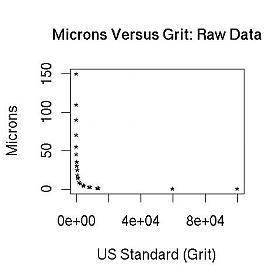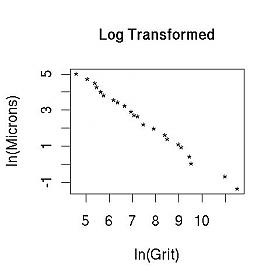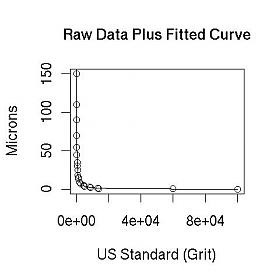Results 1 to 10 of 20
-
04-19-2008, 07:03 PM #1Member

- Join Date
- Mar 2008
- Posts
- 77
Thanked: 11 Grit to mesh to micron conversion
Grit to mesh to micron conversion
I don't know if this has been posted before, or even if it's interesting. But I found a conversion chart for grits and microns (and meshes, whatever those are).
http://www.faceters.com/askjeff/answer67.shtml
To my understanding, hones are measured in grits, while pastes are measured in microns. This chart helped me see the connection. Maybe it will do someone else some good too.
Maybe it will do someone else some good too. 
-
The Following 2 Users Say Thank You to HenrikWL For This Useful Post:
niftyshaving (12-28-2009), tinkersd (09-26-2011)
-
04-19-2008, 09:04 PM #2

Mesh is usually used with diamond hones.
No matter how many men you kill you can't kill your successor-Emperor Nero
-
04-19-2008, 11:09 PM #3There is no charge for Awesomeness



- Join Date
- Aug 2006
- Location
- Maleny, Australia
- Posts
- 7,977
- Blog Entries
- 3
Thanked: 1587
Based on that chart, and assuming the data it contained was not rounded or approximated too much (maybe a big assumption, and there's some evidence that it has been to some extent), I just quickly ran a quick analysis to get a functional form for the relationship between grit and microns.
A graph of the raw data shows an exponential relationship (decay):

This is confirmed by the almost linear relationship when the natural logarithm of each variable is taken:

Treating the numbers in the table as data, and assuming a functional form between Microns and Grit of
Microns = C x Grit^B
(and including "measurement" error), the relationship between Microns and Grit is estimated to be:
Estimated Microns = 11764.71 x Grit^(-0.93589)
with approximate 95% Confidence intervals of (9146.074, 15133.100) for C and (-0.969, -0.903) for B.
This estimated relationship fits the original data quite well (original data are the points, the estimated relationship is the line):

The fidelity of the estimated relationship breaks down a little for higher grits. This is most likely due to increased rounding or approximation in, and sparsity of, the original data at higher grits. Note also that this is a local approximation - this relationship may not hold at grits outside the range of those included in the table.
So, if you had a Shapton 16k ceramic on glass and you wanted to know its grit, using the formula above you get:
Estimated Microns = 11764.71 x 16000^(-0.93589) = 1.37
Of course, a prediction error or confidence interval should accompany this estimate. A very approximate 95% confidence interval is (0.78, 2.41).
A little bit of maths can convert the formula into one that predicts grit if you know the Micron rating:
Grit = (Microns/11764.71)^-1.0685
So, using this one, a 0.92 micron hone is predicted to have a grit of 24440.42, with an approximate 95%CI for the prediction of (13404.45, 46542.28).
More data, accurately measured, would yield formulae with more precise (and accurate) estimates.
James.<This signature intentionally left blank>
-
04-19-2008, 11:23 PM #4
-
04-21-2008, 01:42 AM #5There is no charge for Awesomeness



- Join Date
- Aug 2006
- Location
- Maleny, Australia
- Posts
- 7,977
- Blog Entries
- 3
Thanked: 1587
OK, OK. I actually found some data from another source that includes some Shapton derived micron measurements. I couldn't find the formula that Shapton used, but as a quick and dirty attempt to reproduce the equation I ran a similar analysis as the one above on the new data.
The results were:
Estimated Microns = 14755.41 x Grit^(-1.00044)
(If anyone wants the confidence intervals so they can work out the prediction error, let me know )
)
This one just looks like a simple inverse relationship, which I guess makes physical sense. Does anyone know the Micron measurement of a grit of 1? Depends on the makeup of the grit, I suppose - based on the data, it looks like 1 Grit = 14755 microns in this case. So a simpler approximate formula is
Estimated Microns = 14755/Grit.
Anyway, with this data the Shapton-based microns work out better (16K = 0.918 microns), but the Norton-based micron calculations are a bit screwed (8k = 1.84 microns).
Again, if you want to predict Grit using known Micron values, you can use this one based on the simplified formula:
Estimated Grit = 14755/Microns
So, e.g., 0.5 micron Chromium Oxide power is predicted to be 29510 grit (approx. 30k) using this formula.
James.<This signature intentionally left blank>
-
04-21-2008, 01:49 AM #6

Well, atleast you didn't blow your day reading strange posts.
-
04-21-2008, 01:54 AM #7
-
04-21-2008, 05:34 AM #8There is no charge for Awesomeness



- Join Date
- Aug 2006
- Location
- Maleny, Australia
- Posts
- 7,977
- Blog Entries
- 3
Thanked: 1587
Yeah, sorry guys.

I thought that although a table is useful, a formula for working out grit to micron conversions (and back) might also be useful.
To work out grit when you know microns you can use:
Estimated Grit = 14755/Microns
And to work out microns when you know grit you can use:
Estimated Microns = 14755/Grit
So, for example, say you knew your diamond paste was 0.25 microns. Using the first formula you could work out what grit that was (roughly) by plugging 0.25 into it:
Grit = 14755/0.25 = 60K (or close enough).
On the other hand, say you knew your Shapton Pro has a grit of 30k, but you want to know what that is in microns. You can use the second formula to work that out:
Microns = 14755/30000 = 0.5 (or close enough).
The formulae are not the be all and end all though, because I worked them out based on data I found using Shapton's figures, which may only hold for their hones. For example, there seems to be a general consensus that the Norton 8k is about 3 microns. But if you put 8000 into the second formula you get:
Microns = 14755/8000 = 1.8 microns....
James.<This signature intentionally left blank>
-
The Following 3 Users Say Thank You to Jimbo For This Useful Post:
doorsch (08-06-2015), joke1176 (11-21-2008), leadingedge (05-18-2012)
-
05-18-2009, 01:34 AM #9
 A more complete Comparison
A more complete Comparison
I have been lurking here for a couple months now, and when I came across this thread I decided that I needed to try to contribute something to the forum.
I am attaching a PDF of a grit comparison that I have been working on for a couple years as I happen across new information. Hopefully it is more accurate than most, since almost all figures come from the manufacturers themselves.
I'm interested greatly if anyone catches any errors or has something else to add to the list, so please let me know.
BTW, I'm lovin the wealth of information here, it's good to learn from skilled mentors!
-
The Following 6 Users Say Thank You to Smokintbird For This Useful Post:
JimR (05-19-2009), matt321 (05-18-2009), MuzzleVelocity (05-18-2009), niftyshaving (12-28-2009), simpleman (02-08-2011), StraightRazorDave (05-18-2009)
-
05-18-2009, 05:18 AM #10

I'm curious as to what one grit would look like. I'm imagining a rock about the size of a baseball. I'm probably way off, though. Or does that even make sense?


 4Likes
4Likes LinkBack URL
LinkBack URL About LinkBacks
About LinkBacks






 Reply With Quote
Reply With Quote



